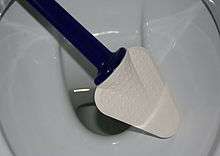Toilet brush

A toilet brush is a tool for cleaning a toilet bowl. The modern plastic version was invented in 1932 by William C. Schopp of Huntington Park, California, US and later patented in 1933 by The Addis Brush Company.
Generally the toilet brush is used with toilet cleaner or bleach. The toilet brush can be used to clean the upper area of the toilet, around the bowl.[1] However, it cannot be used to clean very far into the toilet's U-bend and should not be used to clean the toilet seat.[2]
In many cultures it is considered impolite to clean away biological debris without the use of chemical toilet cleaning products, as this can leave residue on the bristles. By contrast, others consider it impolite not to clean away biological debris immediately using the toilet brush.[3]
A typical toilet brush consists of a hard bristled end, usually with a rounded shape and a long handle. Today toilet brushes are commonly made of plastic, but were originally made of wood with pig bristles or from the hair of horses, oxen, squirrels and badgers.[4] The brush is typically stored in a holder, but in some cases completely hidden in a tube.
An electric toilet brush is a little different from a normal toilet brush. The bristles are fastened on the rotor of a motor which works similar to an electric tooth brush. The power supply is attached without any metal contact via electromagnetic induction.
In recent years, there has been a general shift in design with a new emphasis on ergonomically designed brushes. Further design enhancements have included innovative holders that snap shut around the bristled end, thereby preventing the release of smells, germs and other unpleasantries.[5]
Further development of the traditional toilet brush focus on the risk of germ incubation within the brush holder. A toilet brush has been patented which introduces a reservoir of anti-bacterial fluid, allowing the brush to be dipped and sanitized after each use.[6]
Recent developments
In recent years many new products aiming to reinvent the traditional toilet brush have emerged to the market.
- The LooBlade is a toilet brush with an 8-blade silicone head and hydrophobic properties that sheds water and dries quickly. It is claimed to be able to kill 99.9% of germs during and after cleaning. It was invented by Garry Stewart.[7]
- The Loogun is an alternative to the toilet brush. It's a pressure washer that sprays a powerful jet of clean water that washes away stubborn marks both above and below the water line. The device never touches the toilet, so the device stays hygienic and safe for children.[8]
- The Handi Sani is a self-cleaning toilet brush. It works by attaching the Handi Sani brush holder to the side of the tank with one small hose running into the tank to take advantage of clean water, and another hose running into the toilet bowl for proper draining. The brush is placed inside the Handi Sani so that when the toilet is flushed, the attachment fills up with clean water while simultaneously draining the dirty water into the toilet bowl.[9]
See also
- Automatic self-clean toilet seat
- Bidet
- Self-cleaning toilet bowl
- Shit stick
- Toilet (room)
- Washlet
- Xylospongium
References
- ↑ How to clean a toilet, WikiHow, URL accessed September 11, 2010
- ↑ How to use a toilet brush, WikiHow, URL accessed September 11, 2010
- ↑ A-Z of Manners - toilet etiquette, URL accessed September 11, 2010
- ↑ inventors.com, URL accessed January 20, 2007
- ↑ "oxo GG SS toilet brush". Archived from the original on July 22, 2009. Retrieved 31 August 2008.
- ↑ "Toilet brush and holder".
- ↑ "A toilet brush revolution is happening, and it's called LooBlade - Geek.com". 13 October 2015.
- ↑ "This Amazing Gadget Proves That Toilet Brushes Are Dirty, Terrible Things". 3 June 2016.
- ↑ Sani, Handi. "Handi Sani™: The World's First Self-Cleaning Toilet Brush". PRLog.